|
|
|
Sort Order |
|
|
|
Items / Page
|
|
|
|
|
|
|
| Srl | Item |
| 1 |
ID:
101162
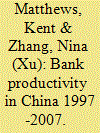

|
|
|
|
|
| Publication |
2010.
|
| Summary/Abstract |
This study examines the productivity growth of the nationwide banks of China and a sample of city commercial, banks for the ten years to 2007. Using a bootstrap method for the Malmquist index, estimates of the total factor productivity growth are constructed. Five different models of inputs and outputs based on variants of the Intermediation and Production approaches and non-performing loans are treated as a bad output, are examined for the purpose of arriving at a robust measure. The productivity growth of the state-owned commercial banks (SOCBs) is compared with the joint-stock banks (JSCBs) and city commercial banks (CCBs). In general, average TFP growth has been neutral over the period for the SOCBs and JSCBs but positive for the CCBs in the second part of the period. Efficiency gains (catch-up) were obtained through cost reduction and technical innovation was associated with greater diversification of revenue away from interest earnings. The opening up of the banking market has not led to a discernible improvement in bank productivity growth.
|
|
|
|
|
|
|
|
|
|
|
|
|
|
|
|
| 2 |
ID:
101163
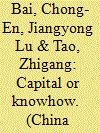

|
|
|
|
|
| Publication |
2010.
|
| Summary/Abstract |
China's success in attracting foreign direct investment has been cast in doubt as mainly a transfer of capital, not knowhow, because its financial system is incapable of allocating domestic savings and hard-earned foreign reserves to domestic enterprises. To shed light on this debate, we examine the determinants of equity sharing in Sino-foreign joint ventures with the premise that the roles of foreign direct investment (in transferring capital or knowhow) should be reflected in equity sharing between multinational firms and local firms. Our empirical analysis offers strong evidence for foreign direct investment as a transfer of knowhow, but limited support for foreign direct investment as a transfer of capital, which points to the need for further reform in China's financial system.
|
|
|
|
|
|
|
|
|
|
|
|
|
|
|
|
| 3 |
ID:
101155
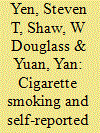

|
|
|
|
|
| Publication |
2010.
|
| Summary/Abstract |
The effect of cigarette smoking on self-reported or assessed health (SAH) has been considered in several studies, with some surprising results, but smoking behavior has received less attention in studies in countries like China, than in the United States and various European countries. In this manuscript the variation in an ordinal endogenous SAH variable is modeled with an ordinal endogenous cigarette smoking variable, using the copula approach to accommodate skewness in the error distribution. The treatment approach avoids several selection issues that could bias empirical estimates. The empirical model is estimated for a random sample of adult males from nine Chinese provinces in the 2006 China Health and Nutrition Survey. The results for our sample suggest that heavy smokers are more likely to report excellent health. Government and those in health policy might target heavy smokers with the message that quitting does result in benefits, keeping in mind that their own reported assessment of their health is itself a function of several factors.
|
|
|
|
|
|
|
|
|
|
|
|
|
|
|
|
| 4 |
ID:
101165
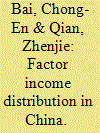

|
|
|
|
|
| Publication |
2010.
|
| Summary/Abstract |
This paper investigates changes in aggregate labor share in China during 1978 and 2007 with a particular focus on the 1995-2007 period during which official statistics report a drop of 12.45 percentage points in labor's share of national income (labor share). Our main findings are: (1) The reported fall in aggregate labor share is overstated. According to the official statistics released by the NBS (2007a), the labor share fell 5.25 percentage points from 2003 to 2004. However this dramatic decline, 42.16% of the total reported decline of the labor share from 1995 to 2007, is completely due to the changes in the way NBS break down the operating surplus state-owned and collective-owned farms and the mixed income of the owners of individual economy; (2) For the last three decades, two main forces have been driving shifts in the aggregate labor share: (i) structural transformation between the agriculture and non-agriculture sectors and (ii) shifts in the labor share within the industry sector; (3) From 1995 to 2003, these two effects are both negative and together drive down aggregate labor share by 5.48 percentage points. The structural change explains 61.31% of the decline and the remaining 38.69% of the decline is due to the changes in the labor share within sectors, primarily in the industry sector; (4) Labor share in agriculture is lower than labor share in services. Therefore, when the service sector grows relative to the agriculture sector in the economy, the aggregate labor share of income declines; and (5) Restructuring of the SOEs and expanded monopoly power are the main reasons for the decline of labor share within industry after 1998. Relative price shifts, the factor input ratio, and biased technological progress are all insignificant forces for this decline because the substitution between factors in the industry sector is nearly unit elastic.
|
|
|
|
|
|
|
|
|
|
|
|
|
|
|
|
| 5 |
ID:
101153


|
|
|
|
|
| Publication |
2010.
|
| Summary/Abstract |
This paper studies how industry specialization, diversification, and churning affect unemployment rates in Chinese cities. Using a city level panel data set from 1997 to 2006, we find that in contrast to the evidence from developed countries, industry diversity is positively and significantly associated with unemployment rates, possibly due to the high degree of industry churning during the sample period. We also find that the specialization of construction industry and wholesale and retail trade industry can significantly decrease unemployment rate, but specializing in finance industry increases unemployment rate. Urban growth, market maturity measured by the proportion of private sector employment, and human capital can decrease unemployment rate. The effect of industry structure on unemployment instability is also discussed.
|
|
|
|
|
|
|
|
|
|
|
|
|
|
|
|
| 6 |
ID:
101161


|
|
|
|
|
| Publication |
2010.
|
| Summary/Abstract |
While there is a large and growing body of research describing and analyzing changes in the Chinese income distribution, researchers have paid considerable less attention to inequality of opportunity. The aim of this paper is to contribute to filling this gap in the literature. The two main questions addressed empirically for the first time in a Chinese context are: to what extent are individuals' incomes and individual income differences due to factors beyond the individual's control (in Roemer's terminology "circumstances") and to what extent are they due to outcomes of the individual's own choices ("effort"). What is the relationship between income inequality and inequality of opportunity?
For this purpose we use data from the China Health and Nutrition Survey collected from nine provinces during the period 1989 to 2006. The CHNS has detailed information about incomes and other factors enabling us to construct a host of circumstance and effort variables for the offspring.
We find that China has a substantial degree of inequality of opportunity. Parental income and parents' type of employer explain about two thirds of the total inequality of opportunity. Notably, parental education plays only a minor role implying that parental connections remain important. The results show that the increase in income inequality during the period under study largely mirrors the increase in inequality of opportunity. Thus, increased income inequality does not reflect changes in effort variables, or expressed differently, increased income inequality has not been accompanied by a decrease in inequality of opportunity.
|
|
|
|
|
|
|
|
|
|
|
|
|
|
|
|
| 7 |
ID:
101156


|
|
|
|
|
| Publication |
2010.
|
| Summary/Abstract |
This paper explores the relationship between informal and formal lending in China with consideration of how the strength of informal lending might affect microcredit. Lending relationships involving trust are investigated using original survey data from over 1500 farm households. Econometric results confirm a relationship between trust and informal lending, and mistrust and formal lending. With over 67% of farm households borrowing from friends and relatives the economic significance between this form of informal lending and borrowing from Rural Credit Cooperatives and Micro Finance Institutions cannot be overlooked.
|
|
|
|
|
|
|
|
|
|
|
|
|
|
|
|
| 8 |
ID:
101160


|
|
|
|
|
| Publication |
2010.
|
| Summary/Abstract |
This paper performs a plot-level analysis of the impact of land rental market participation and off-farm employment on land investment, input use, and rice yields for 215 plots cultivated by 52 households in three villages in Northeast Jiangxi Province. Our findings show that households that rent extra land are relatively more productive, but contradict results of earlier studies which found that tenure status of plots affects the level of land investments. We further find that off-farm employment does not significantly affect rice yields. This result contradicts those of earlier studies which found that the negative lost-labor effect of off-farm employment dominates the positive income effect. Another novel finding is that people working locally off-farm tend to switch from green manure planting towards the use of organic manure on their rice plots. We conclude that policies that will further stimulate the development of land rental markets, which is still in its infancy, can contribute significantly to higher rice production in Southeast China. Another implication of our results is that worries about the negative impact that the continuously growing off-farm employment may have on China's goal to remain self-sufficient in grain production are less relevant at the moment for the region examined in our study.
|
|
|
|
|
|
|
|
|
|
|
|
|
|
|
|
| 9 |
ID:
101159
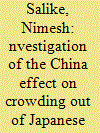

|
|
|
|
|
| Publication |
2010.
|
| Summary/Abstract |
This paper applies a dynamic panel model to investigate whether China is crowding out Japanese foreign direct investment (FDI) from other economies of Asia. We examined this with industry-level data on Japanese FDI flows into Asian economies. In order to deal with possible problems of serial correlation and endogeneity, we estimated coefficients using a difference and system generalized method of moments to examine the "China effect" on industries. We found a significantly high degree of crowding out effect by China on its Asian counterparts. Among twelve industries, a crowding out effect was found in nine industries, including electrical & electronics-the biggest industry for Japanese FDI. However, a complementary effect was found in two industries, one of them being transport, which is the second biggest industry for Japanese FDI. We conclude that while China's rise is a prominent threat for the region, it could be transformed into an opportunity in vertically fragmented industries.
|
|
|
|
|
|
|
|
|
|
|
|
|
|
|
|
| 10 |
ID:
101154


|
|
|
|
|
| Publication |
2010.
|
| Summary/Abstract |
In this paper, I discuss the actual conditions and the determinants of co-residence between older parents and their children in China, especially the impact of bequest motives on parent-child co-residence, using micro data from the "Survey of Living Preferences and Satisfaction," conducted at Osaka University. More specifically, I use three subsamples of older respondents (those who live in urban areas, those who live in rural areas, and the pooled sample of both) to analyze the impact of bequest motives and other factors on the probability of parent-child co-residence. The results are as follows: bequest motives are strong in China, with more than 60% of respondents having a bequest motive, and the parent-child co-residence rate is also high (about 60%). Turning to the determinants of parent-child co-residence, children of urban parents are more likely to live with their older parents if their parents have a bequest motive, own their own homes, and live in an area where housing prices are high, a result which is consistent with both the selfish life-cycle and altruism models. Children are more likely to live with their older parents if their parents have a bequest motive in both the rural and combined samples, which implies that children are selfishly motivated and that the selfish life-cycle model applies in China.
|
|
|
|
|
|
|
|
|
|
|
|
|
|
|
|
| 11 |
ID:
101152
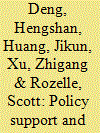

|
|
|
|
|
| Publication |
2010.
|
| Summary/Abstract |
Most farms in China are small and vulnerable to the forces of powerful markets. Recognizing the challenges of small farming, China has promoted farmer professional cooperatives (FPCs) during the past two decades. The overall goal of this study is to analyze the emergence and current status of FPCs, the nature of recent policy initiatives and the role of government policies that have played in promoting recent trends. Based on a unique panel data from two rounds of national representative surveys of 380 villages in 2003 and 2009, this paper shows that while there was nearly no FPC in late 1990s, there were FPCs in 21% of China's villages and these FPCs provided services to about 24 million farm households in 2008. The determinants of FPC analysis show that the role of the government is of primary importance. Policy support measures and, most likely, the new legal setting in China after the passage of the 2006 FPC law, account for most of the growth of FPCs.
|
|
|
|
|
|
|
|
|
|
|
|
|
|
|
|
| 12 |
ID:
101157
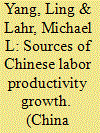

|
|
|
|
|
| Publication |
2010.
|
| Summary/Abstract |
We decompose labor productivity growth from 1987 to 2005 by examining six partial factors (both supply and demand): changes in value-added coefficients, labor inputs, shares of sectoral demands that are fulfilled domestically, input mix, and the intra-sectoral shares and intersectoral mix of final demand. Our analysis confirms that simply by virtue of its size and extremely low level of labor productivity, China's farm sector continues to weigh heavily in China's overall economic advances. Labor savings have levied the largest influence on the labor productivity on all sectors across all three study subperiods. We find that this transition is highly correlated with capital deepening that accompanies China's opening up process. Still, changes in the intra-sectoral shares and the intersectoral mix of China's final demand also have become quite strong, especially in recent periods. Due to ever-increasing competitive pressures as China continues to open, changes in industries value-added coefficients have tended to counteract some of the positive benefits of labor savings for most sectors. The effects on changes in labor productivity of technology change and changes in the use of imports have been comparatively negligible and any variation in their sectoral effects have been waning over time.
|
|
|
|
|
|
|
|
|
|
|
|
|
|
|
|
| 13 |
ID:
101164


|
|
|
|
|
| Publication |
2010.
|
| Summary/Abstract |
This paper develops an optimization model to analyze the policy formulation under China's dual-track grain procurement system. By capturing the redistribution objective and the urban food security objective in a political preference function, we provide some rigorous explanations of three important aspects of China's grain policies: the choice of the dual-track procurement system over the lump-sum tax scheme as a means of extracting economic surpluses from the grain sector; the suppression of the procurement price to its minimum until the mid-1990s; and the switch from taxing to subsidizing grain production at end-1996. Our findings underscore the paramount importance of the urban food security objective behind the evolution of China's grain procurement policy, including the liberalization of the system in the 2000s.
|
|
|
|
|
|
|
|
|
|
|
|
|
|
|
|
| 14 |
ID:
101158


|
|
|
|
|
| Publication |
2010.
|
| Summary/Abstract |
This paper ranks the economic research institutions in China based on publications in the SSCI economics journals from 2000 through 2009 and finds that the gap in the research capacity of economic research institutions between the mainland and Hong Kong is very large, even though the difference in overall quality is not so significant. This paper can reflect successes and failures of the reform of the economics education in China over the past decade and give important implications for the ongoing reforms as well.
|
|
|
|
|
|
|
|
|
|
|
|
|
|
|
|
|
|
|
|
|